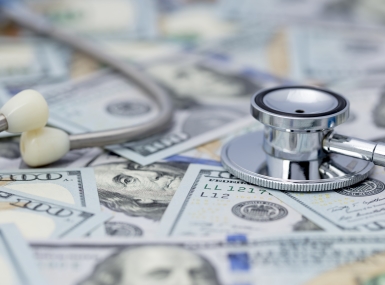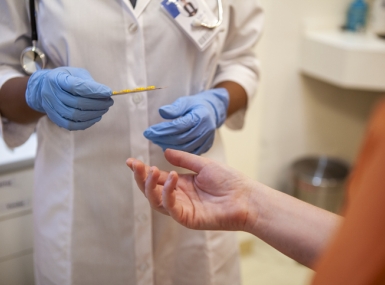A look at funding for COVID-19 vaccine planning and distribution by counties
Author

Blaire Bryant
Upcoming Events
Related News

The development of a COVID-19 vaccine that would provide immunological protection to the virus is a critical component to ending the current public health crisis. In September, following the release of the U.S. Centers for Disease Control and Prevention’s (CDC) vaccine framework for local planning efforts, states and local jurisdictions were given 30 days to develop interim plans for vaccine distribution.
Now that we are past the October 16 state plan submission deadline, state and local health officials have underscored the crucial need for federal funding to support the daunting task of vaccine distribution and administration by state and local governments.
Learn More
Federal funding and mandates for vaccine development and distribution
Funding support has become critical for state planning and distribution efforts.
Counties support over 900 hospitals, 824 long-term care facilities and 1,943 local health departments — which will all play an integral role in vaccine distribution.
The infrastructure that these and other approved immunizing entities will need to prepare for the mass distribution of a vaccine is extensive, and will require enhanced resources for vaccine storage, provider staffing and training, and updating technology and data systems to track vaccine inventory and ensure that individuals are getting accurate dosages.
The CDC has released approximately $200 million in funding to states and local governments to date for vaccine planning efforts, much of which did not reach county health officials. However, aside from this allocation, state health officials are estimating that approximately $8 billion will be needed in total, of which:
- $3 billion would be used for workforce recruitment and training,
- $1.2 would be used for cold supply chain management which includes transportation, storage, equipment and training for staff, and
- $500 million would be used for technology and data system enhancements.
No official announcement has been made by CDC or the U.S. Department of Health and Human Services (HHS) on additional funding distributions to states and localities for vaccine planning and distribution efforts.
The federal government will cover the cost of purchasing vaccines.
Despite concerns over how to fund the distribution of a COVID-19 vaccine, the administration has taken on the cost of purchasing vaccine dosages from manufacturers. Upon approval of a vaccine, set dosage amounts will be purchased and shipped with related supplies to vaccine administration sites.
The Coronavirus Aid, Relief, and Economic Security (CARES) Act (P.L. 116-136), allocated billions of dollars in funding to purchase COVID-19 vaccines. According to data released by HHS, Operation Warp Speed, the federal initiative tasked with overseeing the development of coronavirus countermeasures, has spent approximately $10 billion on COVID-19 vaccine manufacturing and therapeutics.
The vaccine will be provided free of charge to most Americans, especially to vulnerable populations, during the public health emergency.
Also included in the CARES Act were provisions mandating that “group health plans and health insurance issuers…cover (without cost-sharing) any qualifying coronavirus preventive service,” including vaccines. On Oct. 28, the Centers for Medicare and Medicaid Services (CMS) released an interim final rule with comment period (IFC) that implemented these provisions.
Under the rule, any future FDA-approved COVID-19 vaccine must be provided at no cost to beneficiaries enrolled in Medicare, Medicare Advantage, Medicaid and most private insurance providers. The covered service is a requirement for any state Medicaid and Children’s Health Insurance program receiving the temporary increase for federal medical assistance (FMAP) that was provided by the Families First Coronavirus Response Act (FFCRA, P.L. 116-127).
The mandate would provide Medicaid beneficiaries free access to the vaccines during the public health emergency (PHE). However, the agency will allow for flexibility on this requirement after the PHE has been lifted.
The temporary 6.2 percent FMAP increase provided in FFCRA is set to expire at the end of the PHE in January 2021. While the chances of the PHE being renewed are uncertain at this time, counties have advocated for sustained federal aid for state Medicaid programs, which have seen dramatic boosts in enrollment during the course of the pandemic. Given that widespread availability of a COVID-19 vaccine is not projected until well into 2021, without an extension on federal support for Medicaid, many beneficiaries could be charged out of pocket costs for vaccinations.
HHS and the Department of Defense have taken steps to ensure that long-term care facilities have access to a COVID-19 vaccine at no cost.
In October, the agencies announced new agreements with CVS and Walgreens to provide and administer COVID-19 vaccines to residents in long-term care settings nationwide.
The initiative will be managed by the Pharmacy Partnership for Long-Term Care Program, which will provide complete management of the COVID-19 vaccination process at no cost to the facilities and will minimize the burden of ordering and administering vaccines for these facilities on local health officials.
States and counties are permitted to use federal relief funds to pay for vaccine planning and distribution efforts.
As states and localities continue to advocate for additional federal aid to support vaccination efforts, health officials have begun looking elsewhere for this much-needed support.
CMS has indicated that recipients of the $175 billion Provider Relief Fund (PRF), established by the CARES Act to provide fiscal relief to hospital and health care entities, may use these funds to cover the cost of vaccine administration for uninsured individuals who are not eligible for or enrolled in Medicaid.
In addition to the PRF, a new $150 billion Coronavirus Relief Fund (CRF) was established under the CARES Act, which provides state, county and municipal governments with populations of over 500,000 people with federal aid needed to address necessary expenditures incurred due to the coronavirus public health emergency.
As permitted by the CARES Act, states and localities may use CRF dollars towards medical expenses that include vaccine distribution and administration.
For example, Sacramento County has allocated a portion of its CRF allocation towards purchasing supplies and resources necessary to effectively distribute a COVID-19 vaccine once it is approved and made publicly available.
We also have seen counties, such as Pima County, Ariz., use CRF dollars to purchase facilities and store vaccinations once they are made available for future use.
Federal funding and mandates for vaccine development and distribution
Coronavirus: Preparedness and Response Supplemental Appropriations Act (P.L. 116-123)
Funding Amount Allocated: $61 million
Provided additional funding for FDA “Salaries and Expenses” for COVID-19 response, which includes “the development of necessary medical countermeasures and vaccines.”
Funding Amount Allocated: $3.1 billion
Provided additional funding for the HHS “Public Health and Social Services Emergency Fund.” The funding was provided to help respond to COVID-19, including the “development of necessary countermeasures and vaccines.” These funds can also be used “for the construction, alteration, or renovation of non-Federally owned facilities for the production of vaccines.” The bill also instructs the HHS Secretary to use these funds to purchase vaccines.
Funding Amount Allocated: $300 million
Provided additional funding made available to the “Public Health and Social Services Emergency Fund” for the same purposes listed above. However, the funding is only available if the HHS Secretary notifies Congress that the $3.1 billion allocation “will be obligated imminently and that additional funds are necessary to purchase vaccines...”
Families First Coronavirus Response Act (P.L. 116-127)
Funding Amount Allocated: Medicaid FMAP assistance increased temporarily by 6.2% for each state/territory
States were only eligible for this temporary increase in federal medical assistance if the State provides “coverage under such plan (or waiver), without the imposition of cost sharing…for any testing services and treatments for COVID-19, including vaccines...”
Coronavirus Aid, Relief and Economic Security Act (CARES, P.L. 116-136)
Funding Amount Allocated: $80 million
Provided additional funding for FDA “Salaries and Expenses” for COVID-19 response, which includes “the development of necessary medical countermeasures and vaccines.”
Funding Amount Allocated: $706 million
Provided additional funding for NIH. Mandates no less than $156 million of these dollars be used “for the study of, construction of, demolition of, renovation of, and acquisition of equipment for, vaccines and infectious diseases research facilities.”
Funding Amount Allocated: $3.5 billion
Provided additional funding for the HHS “Public Health and Social Services Emergency Fund.” The funding was provided to help respond to COVID-19, including the “development of necessary countermeasures and vaccines.” $3.5 billion of this funding is allocated to the Biomedical Advanced Research and Development Authority for “manufacturing, production and purchase....of vaccines, therapeutics, diagnostics...” These funds can also be used “for the construction, alteration, or renovation of non-Federally owned facilities for the production of vaccines.”
N/A Required the strategic national stockpile to include PPE and other medical supplies “required for the administration of drugs, vaccines and other biological products.”
N/A Mandates that the Secretaries of HHS, Labor and Treasury “require group health plans and health insurance issuers…to cover (without cost-sharing) any qualifying coronavirus preventive service,” including vaccines.
Requires any licensed COVID-19 vaccine be covered by Medicare Part B program without cost-sharing.

Attachments
Related News

NACo offers new Medicaid resources as Congress advances Budget Resolutions with major Medicaid reform implications
On April 10, the U.S. House of Representatives voted to adopt a Senate-passed budget resolution, marking the next step in the budget reconciliation process. The proposed funding levels therein represent significant potential cost shifts to counties, particularly in the area of Medicaid financing. To help county leaders understand what’s at stake, NACo has developed two new resources.

County Countdown – April 21, 2025
Every other week, NACo's County Countdown reviews top federal policy advocacy items with an eye towards counties and the intergovernmental partnership. This week features the ARPA reporting deadline, a budget reconciliation update and more

U.S. House reintroduces legislation to address the Medicaid Inmate Exclusion Policy
Two bipartisan bills aimed at addressing the Medicaid Inmate Exclusion Policy (MIEP) were recently reintroduced in the U.S. House of Representatives.